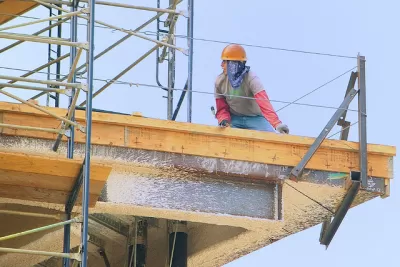With an aging workforce and few new workers entering the sector, cities could find themselves short of the workers needed to build and maintain projects funded by the Infrastructure Investment and Jobs Act.

According to a Brookings Institution report, the infrastructure sector is facing a ‘silver tsunami’ as a large portion of the workforce reaches retirement age, prompting concerns about who will build the many infrastructure projects being pushed through thanks to federal funding. As Kery Murakami writes in Route Fifty, “The Bureau of Labor Statistics projects that 1.7 million people employed in the infrastructure sector will leave their jobs each year between 2021 and 2031.”
This is due in large part to the demographics of the infrastructure workforce. According to Murakami, “nearly three-fourths of transit and intercity bus drivers are 45 years old or older, as are 55.7% of power distributors and dispatchers and 53.8% of rail yard engineers.” The situation is even more dire in the transit sector, where “Up to 50% of bus maintenance employees are eligible to retire in the next three to five years.” Meanwhile, “Only 11% of infrastructure workers are 24 years or younger.”
The difficulty of infrastructure jobs also means fewer young workers are entering the industry, and more workers are opting out. “The number of workers leaving jobs in construction, transportation, warehousing, and utilities for other jobs grew by almost 20% last year.”
FULL STORY: The ‘Silver Tsunami’ Expected to Hit the Infrastructure Sector

Planetizen Federal Action Tracker
A weekly monitor of how Trump’s orders and actions are impacting planners and planning in America.

Map: Where Senate Republicans Want to Sell Your Public Lands
For public land advocates, the Senate Republicans’ proposal to sell millions of acres of public land in the West is “the biggest fight of their careers.”

Restaurant Patios Were a Pandemic Win — Why Were They so Hard to Keep?
Social distancing requirements and changes in travel patterns prompted cities to pilot new uses for street and sidewalk space. Then it got complicated.

Platform Pilsner: Vancouver Transit Agency Releases... a Beer?
TransLink will receive a portion of every sale of the four-pack.

Toronto Weighs Cheaper Transit, Parking Hikes for Major Events
Special event rates would take effect during large festivals, sports games and concerts to ‘discourage driving, manage congestion and free up space for transit.”

Berlin to Consider Car-Free Zone Larger Than Manhattan
The area bound by the 22-mile Ringbahn would still allow 12 uses of a private automobile per year per person, and several other exemptions.
Urban Design for Planners 1: Software Tools
This six-course series explores essential urban design concepts using open source software and equips planners with the tools they need to participate fully in the urban design process.
Planning for Universal Design
Learn the tools for implementing Universal Design in planning regulations.
Heyer Gruel & Associates PA
JM Goldson LLC
Custer County Colorado
City of Camden Redevelopment Agency
City of Astoria
Transportation Research & Education Center (TREC) at Portland State University
Camden Redevelopment Agency
City of Claremont
Municipality of Princeton (NJ)




























